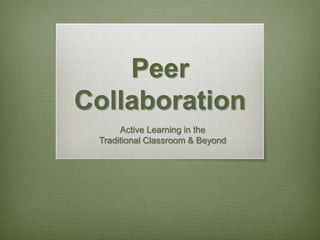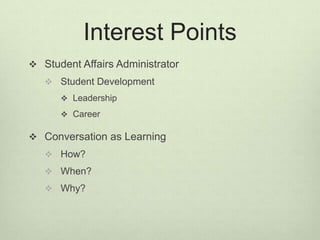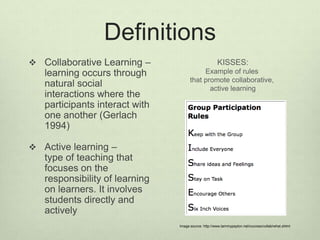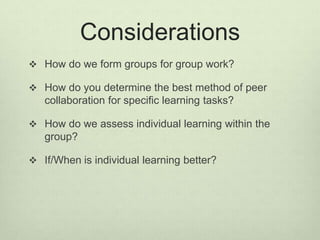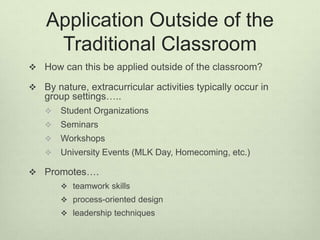Powerpoint Sample
- 1. Peer CollaborationActive Learning in the Traditional Classroom & Beyond
- 2. Interest PointsStudent Affairs AdministratorStudent DevelopmentLeadershipCareerConversation as LearningHow?When?Why?
- 3. Inquiry Questions What is the value of collaborative learning in the classroom?What methods are used in the classroom?Does research support these activities’ effectiveness?What are the criticism/drawbacks?How can these methods be applied outside of traditional classrooms?
- 4. Early ResearchVygotsky (1978)Social Development TheorySocial interaction plays a role in cognitive development“More Knowledgeable Other“Zone of Proximal Development”Gap is where learning actually occursEarly research focused on trying to figure if and when collaborative learning is more effective than individual learningNewer research focuses on on the interactions themselves
- 5. DefinitionsCollaborative Learning – learning occurs through natural social interactions where the participants interact with one another (Gerlach 1994)Active learning –type of teaching that focuses on the responsibility of learning on learners. It involves students directly and activelyKISSES:Example of rules that promote collaborative, active learningImage source: http://www.tammypayton.net/courses/collab/what.shtml
- 6. Focus on Conversation All learning is based on conversationFrom infancy to adulthood – learning occurs through interaction with others“Education initiates us into conversation, and by virtue of that conversation initiates us into thought” - BruffeeLearning communitiesBruffee (1999) – students learn through their interactions within learning communitiesLadson-Billings (1995) – need to develop a common language to promote learning
- 7. Support for CollaborationBruffee – Discussion can spark discussion and increase exposure to new ideas and conceptsSvinicki & McKeachie – “student teaching other students” is the best concrete answer to “what is the most effective method of teaching”Miller & Groccia – cooperative learning promotes an increase in the ability to work with othersPromotes cognitive development“To teach is to learn twice….” -Joseph Joubert, French Moralist & Essayist
- 8. Examples of Collaboration in the ClassroomStudent-led discussion groupsPeer teaching / tutoringTeam-based learning assignmentsSyndicates
- 9. ConsiderationsHow do we form groups for group work?How do you determine the best method of peer collaboration for specific learning tasks?How do we assess individual learning within the group?If/When is individual learning better?
- 10. Application Outside of the Traditional ClassroomHow can this be applied outside of the classroom?By nature, extracurricular activities typically occur in group settings…..Student OrganizationsSeminarsWorkshopsUniversity Events (MLK Day, Homecoming, etc.)Promotes….teamwork skillsprocess-oriented designleadership techniques
- 11. ReferencesBruffee, K. A. (1999). Collaboration, conversation, and reacculturation. In Collaborative learning: Higher education, interdependence, and the authority of knowledge (pp. 3-20). Baltimore: The Johns Hopkins Press.Gerlach, J. M. (1994). "Is this collaboration?” In Bosworth, K. and Hamilton, S. J. (Eds.), Collaborative Learning: Underlying Processes and Effective Techniques, New Directions for Teaching and Learning No. 59.Ladson-Billings, G. (1995). Toward a theory of culturally relevant pedagogy. American Educational Research Journal, 32(3), 465-491.Miller, J. E., & Groccia, J. E. (1997). Are four heads better than one? A comparison of cooperative and traditional teaching formats in an introductory biology course. Innovative Higher Education, 21, 253-273.Svinicki, Marilla, & McKeachie, Wilbert. (2010). Mckeachie's teaching tips. Belmont, CA: Wadsworth Pub Co. Vygotsky, L.S. (1978). Mind and society: The development of higher mental processes. Cambridge, MA: Harvard University Press.

